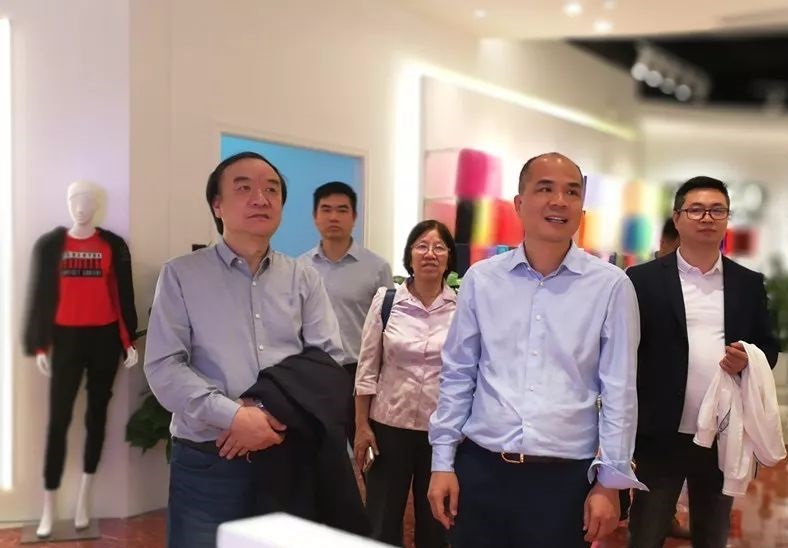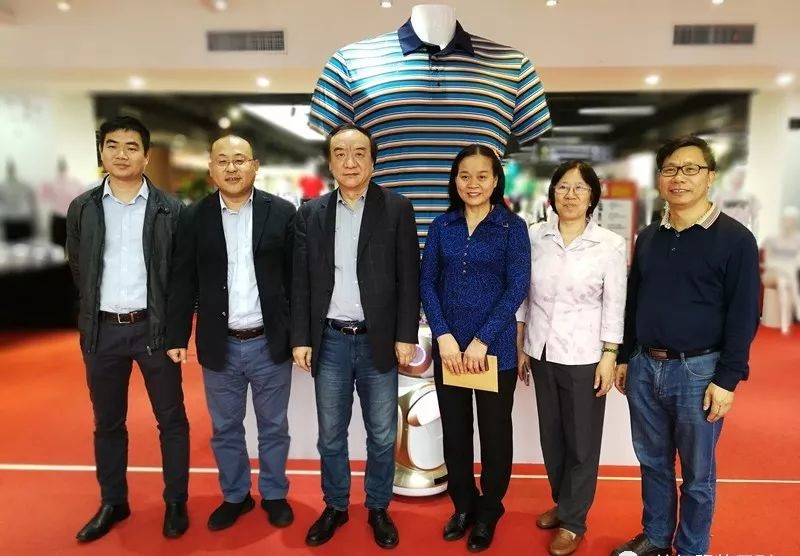Investigation in Guangdong and Shenzhen: New ideas bring new changes
Jun 07, 2018 | by

In this Spring, Sun Huaibin, Vice President of China National Textile and Apparel Council, led the investigation and survey personnel from Department of Industry, Center for Economic Development Research and Industrial Economic Research Institute of CNTAC, China Textile Information Center, etc. to, from multiple perspectives such as the trend of industry operation and opening, market consumption, advanced technology application, talent cultivation, conduct an in-depth investigation on specialized markets, industrial clusters, typical enterprises and specialized universities in Guangzhou and Shenzhen, accompanied by Chen Qianwei, Vice President of Guangdong Textile Association, etc.
Market concepts are changing
Guangzhou International Textile City is the first station of the investigating group. March 5th is the first day of official opening of International Textile City after the year. The specified market that puts into official operation in 2005 is located in Guangzhou Zhongda Business Circle, and adhering to the service concepts of innovation, convergence and leading, it maintains a momentum of rapid development and has become a modern textile wholesale market and global procurement one-stop base with 300,000 square meters and more than 4,000 entity merchants of face and auxiliary materials that integrates the three functions of textile trading, display and business in one. Relying on flexible and agile market response, it is rated as the "barometer" for the economic development of Guangdong.
It is understood in the investigation that in the complex economic environment, International Textile City has kept pace with market changes, continuously improved its service capability and level, and by relying on the first-class hardware foundation and thousands of physical shop resources, it has built up an E-commerce platform for exclusive textile trading - Guangzhou International Textile Network, that is, the operation mode of parallel of online and offline double platforms of “E-commerce + convention&trade”, providing convention&trade, E-commerce, information exchange, talent training and a variety of other services so that the market and merchants become more interdependent and the market live water continues to flow, and it has become an industry benchmark for the format upgrade of specialized markets.
There are design-oriented clothing stores everywhere in the market, and the used raw materials or product design boast a full sense of fashion. Mao Guowei, Deputy General Manager of Guangzhou International Textile City mentioned that now macroeconomic and microeconomic integration is getting closer, and the keying strength between the textile industry chains exceeds any period in history. A new fashion style in Seoul, South Korea will be in bulk sales in Guangzhou International Textile City in 3 days. The changing market at a top speed has enabled the CEOs of Textile City to accelerate and improve their own innovation speeds and capabilities through various trainings and innovations so as to adapt to the changing market environment.
At the symposium, the speeches of nearly 10 enterprise CEOs have made the members of the investigating group see the positive changes in the business philosophies of enterprises brought by the market “barometer” reflected by platforms as well as the consciousness to keep up with the changes of the times. In the past, a variety can be sold for several years, but now dozens or even hundreds of varieties will be sold only in a year. In the face of this change, some enterprises launch a one-two punch: enhance product design capabilities, hold regular “appreciation events” with purchasers, establish R&D teams in Korea, increase product value with R&D design, etc., and these practices have fundamentally changed the business modes of enterprises, and product benefits have been obviously improved; some other enterprises continue to participate in overseas professional exhibitions, which increases their self-confidence in domestic products and overseas markets while opening up overseas markets with products; moreover, even some enterprise CEOs reach a consensus that the experience consumption of physical clothing stores will make considerable development, and Chinese consumers have already been willing to pay for the design. The enhancement in the value of ready-made clothes brought by the rise of individualized consumption will drive the transformation of industrial chains and the emergence of new market opportunities. These are the opportunities we have to seize.
The reporters have learned that among more than 4,000 merchants of Guangzhou International Textile City, 1/3 of then come from Chaoshan, 20% from Lingnan, 20% from Wenzhou and the rest from all over the country. The industry cohesion brought by the inclusive market environment in South China is forming new industrial values and new driving forces for growth. Just like what enterprise CEOs said at the symposium, the national market environment has under gone tremendous changes in recent years, the radiation and cohesion of some regional clothing circles are gradually weakening; however, the leading role of Guangzhou's clothing is not changed but conversely, the quality of the market is still rising. Especially, there is an apparent enhancement in the requirements for design capability of clothes, and there is undoubtedly a groundswell of support for design talents, which is the demand brought by market changes. The market of meeting the needs of the market with personalized products will be infinite. At the symposium, the CEOs call for CNTAC to provide Guangdong garment makers with opportunities to participate in international top fabric exhibitions such as the PV exhibition in France so that more products can go out because they know in their own practice that Chinese product are no worse than foreign products, and they are just lack of channels. They hope that relevant units can provide suitable living environment for the introduction and development of design talents, and contribute for the enterprises to transform their development ways. “The international competitiveness of domestic fabrics has been very strong, so we must have confidence in ourselves.” The speech of Long Zhijiang, Chairman of Yunze Textile Co., Ltd. made the participants full of expectations for the vision of industrial development. The transformation of competition concepts will be bound to bring about the enhancement in our internal forces, and we have seen this kind of change.

Talents are the cornerstone for industry development at a steady pace
Among more than 13,000 graduates every year, the number of graduates in higher vocational colleges majoring in Textile is close to 6,000, and the employment rate is 99.9%. The number reported by Hu Gang, Dean of Guangdong Vocational and Technical College to the investigating team gave a great excitement to the investigating team that has an in-depth understanding of the current situation of textile talents.
Founded in 1985, Guangdong Vocational and Technical College, with the teaching concepts of “seeking truth and strengthening skills, advocating innovation and emphasizing hands-on capacity, promote action with knowledge and knowledge and action supplement each other”, it has experienced the transformation of identity from the national key technical secondary school to the full-time ordinary higher vocational college, and provide more than 30,000 various kinds of textile professionals to the whole society up till now. The college currently occupies an area of 1,127 mu with two campuses, namely Foshan Chancheng Campus and Gaoming Campus. It has 8 departments and 8 divisions and 3 departments, 34 specialized majors and more than 60 professional directions. Furthermore, there are more than 10,000 students and 5,949 students majoring in Textiles and Garments, which is close to 40%. Although it is a comprehensive vocational college, the major of Textile has always been the leading discipline of the college. Thereinto, the major of Modern Textile Technology is the national key construction major supported by the central finance; Dyeing and Finishing Technology, Clothing Design, Knitting Technology and Knitted Apparel, Clothing Art Design and other majors are all demonstration and key majors of Guangdong Province. Three training bases of the college have been supported by the central finance and there are also 5 provincial training bases, and it is the country’s largest professional college that cultivates vocational skills of textiles and garments.
After many years of “teaching and learning”, batches of textile and clothing professionals with professional knowledge and skills go out of the college, and contribute their wisdom and intelligence in the development tide of the textile and clothing industry. Vice President Liu Sen proudly told reporters that many of the students who graduate from the school eventually start their own businesses, and it is precisely their professional skills that boost their confidence.
Due to the requirements of the development of the national economic environment for environment protection, and in response to the strong demand for talents with professional skills, Guangdong Esquel has been here for five years in the training of specialized talents for enterprises. At present, the most desirable students of the college are the graduates from dyeing and finishing technical colleges to the extent that they have been taking turns to ask prices”, and thus it can be seen that the industry is extremely eager for professional talents. In the discussion, the reporters learned that so far, the college's iconic awards come from the major of Textile and Clothing whose teaching ability is evident. Currently, the college is also the “star-level demonstration zone” for employment among the national vocational colleges and the first “star-level demonstration school” for employment in Guangdong Province.
Although the college has strong teaching abilities and optimistic employment prospects, college leaders do not stand still and refuse to make progress. In the discussion, a series of blueprints for the future development of the college has been clearly presented: it expects to complete textile buildings next year, plans to build textile museums and set up research and development platforms, etc. With confidence in the development of the textile industry, it aims to construct a national first-class vocational college so as to cultivate more professional personnel for the industry. Meanwhile, college leaders also spoke bluntly that there are still many shortcomings in the “deep school-enterprise cooperation”, which need to be further explored, and call for CNTAC to involve domestic textile and clothing education resources under the development planning of national strategy of “The Belt and Road” so that China’s textile and clothing education resources will gain greater development on a global scale.
Zhangcha’s dreamy “Dreamweaving Town”
In 2017, Zhangcha hand in a pretty good answer sheet with a total gross regional product of 48959 million yuan, a year-on-year growth of 8.2%. There were 4282 knitting enterprises, and 490 new enterprises are established in 2017, up by 11% from the previous year. In the local place, there were more than 30,000 employees in the knitting industry, 23,180 sets of circular knitting machines and 85 enterprises above designated size, achieving a total output value of more than 35 billion.
The investigating group visited an industrial chain in Zhangcha, from the domestic first “high-speed pass-type direct injection textile inkjet printing machines” of Guangdong Meijia Intelligent Technology Co., Ltd. to high-grade functional knitted fabrics of Guangdong Grand Honor Group Co., Ltd. and Foshan Jiaqian Textile Co., Ltd., to Antoni (International) Co., Ltd. - the largest mercerized cotton garment enterprise in China, and it has seen the development capacity of Zhangcha from equipment manufacturing, fabric research and development to garment production.
As one of the largest knitting industry clusters in China, Zhangcha currently has 26 knitting industrial parks, and its production and trading volume of knitted fabrics takes up one third of the country. In 2017, the output value of mercerized cotton knitted garments in Zhangcha reached 29435 million yuan. At present, Zhangcha has cooperated with many well-known domestic and foreign clothing brands and Internet companies such as Armani, Hugo Boss, K-boxing, Septwolves, Youngor, Goldlion, etc.
At the symposium, Liu Zhicheng, Secretary of Street Work Committee who has taken office in Zhangcha for one year placed great expectations on this industry. Zhangcha boasts a good industry foundation and excellent equipment manufacturing enterprises, fabric production enterprises and clothing enterprises, which makes this industry plate lead the fashion in economic development, and a lot of efforts and measures can be done in this respect. In Liu Zhixing’s efforts, the top priority is to plan the “Dreamweaving Town”. Liu Zhicheng depicted the vision on the map to the research group on the spot: relying on a strong industrial base and superior geographical transportation advantages, build the “Dreamweaving Town” in Guangdong-Hong Kong-Macau Greater Bay Area, including museum display, a variety of trainings, product development, design creativity and other contents, and the knitting industry of Zhangcha will be fully displayed and inherited in this carrier to realize bigger development dreams of the knitting industry of Zhangcha.
In the meanwhile, the government will also take the lead to do well in providing services for enterprises by participating in various exhibitions, competitions and other work.
Zhangcha’s “Dreamweaving Town” has received positive responses from enterprises. At the symposium, many enterprise representatives spoke frankly that the knitting industry of Zhangcha is indeed very big, but it is loose and not strong enough. "Dreamweaving Town" has provided an excellent opportunity for them to achieve development in combination, they are look forward to it very much and hope that the government can speed up the promotion; some enterprises stated combined with the current status of enterprises that, the conception of “Dreamweaving Town” is very good, if it is well-done, it can help enterprises to do things that are difficult to achieve, for instance, recruitment, technology upgrades, introduction of new equipment can be brand new practices, a lot of things can be done, and the results are enterprise benefits and industrial development, which calls for deep thoughts.
Actively changing concepts and adapting to market competitions with new ideas is becoming a new normal in knitting enterprises of Zhangcha, which is bound to bring new changes.








